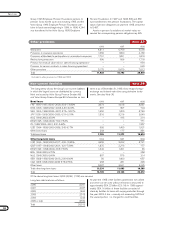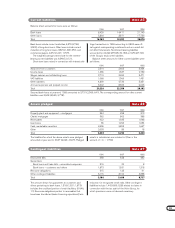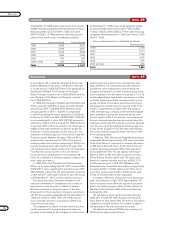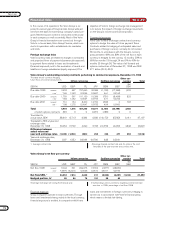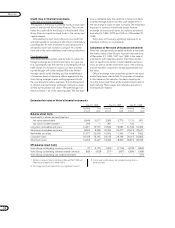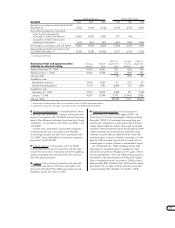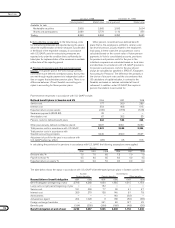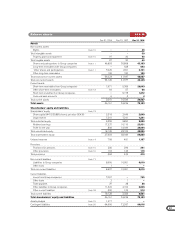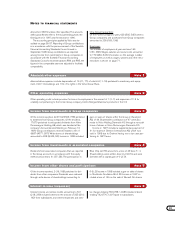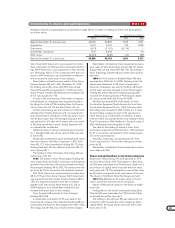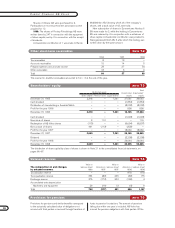Volvo 1998 Annual Report Download - page 78
Download and view the complete annual report
Please find page 78 of the 1998 Volvo annual report below. You can navigate through the pages in the report by either clicking on the pages listed below, or by using the keyword search tool below to find specific information within the annual report.
76
NOTE S
Significant differences between Swedish and U.S.
accounting principles
A. Foreign currency translation. Volvo uses forward
exchange contracts and currency options to hedge the
value of future flows of payments in foreign currency.
Outstanding contracts that are highly certain to be cover-
ed by currency transactions are not assigned a value in
the consolidated accounts.
In accordance with U.S. GAAP, outstanding futures
contracts and currency options are valued at market
through so-called fictive closing. The profits and losses
that thereby arise are included when calculating income.
Unrealized net losses for 1998 pertaining to forwards
and options contracts are estimated at 628 (losses
1,163; profit 3,660).
B. Income taxes. Volvo applies the so-called liability
method for accounting income tax, in accordance with
SFAS 109: “Accounting for income taxes.” In accordance
with this method, deferred tax is calculated on so-called
temporary differences, i. e., the difference between the
accounting value and tax value at enacted future tax
rates.
The greatest difference, relative to U.S. GAAP, is the
principle for determining the valuation allowance. In
accordance with SFAS 109, deferred tax receivables are
reported when it is “more likely than not” that the receiv-
able will be realized. Deferred tax receivables are report-
ed in Volvo’s consolidated accounts only to the degree
that they are balanced by deferred tax liabilities in the
same tax area. The valuation allowance at December 31,
1998, based on U.S. GAAP, was 1,300 (1,500; 1,400)
lower. See also Note 1, “Future changes in accounting
principles in 1999.”
Specification of deferred tax receivables and liabilities
(in accordance with Swedish GAAP) 1996 1997 1998
Deferred tax receivables:
Tax-loss carryforwards 1,640 1,582 1,085
Other tax deductions 106 103 60
Shares and participations 626 236 109
Other deductible temporary differences 2,905 3,838 5,475
5,277 5,759 6,729
Valuation allowance (2,209) (2,578) (2,403)
Deferred tax receivables after deductions for valuation allowance 3,068 3,181 4,326
Deferred tax liabilities:
Taxable temporary differences 4,935 5,324 5,776
4,935 5,324 5,776
Deferred tax liabilities, net 1,867 2,143 1,450
After taking into account offsetting possibilities the items
above are shown in Volvo’s balance sheet as follows:
Other long-term receivables 265 255 368
Other short-term receivables 923 1,514 2,499
Deferred taxes 3,055 3,912 4,317
Deferred tax liabilities, net 1,867 2,143 1,450
C. Tooling costs. Adjustments under this point pertain
to depreciation of capitalized tooling costs in accordance
with U.S. GAAP prior to 1993.
D. Business combinations. There are differences be-
tween Swedish reporting and U.S. GAAP in the method
of accounting for certain acquisitions, particularly in the
recognition and amortization of excess values and
accounting for the tax benefits related to utilization of
loss carryforwards of acquired subsidiaries.
Volvo’s earnings in 1993 include a provision for an
excess value related to Volvo Trucks which resulted from
the exchange of shares with Renault. In accordance with
U.S. GAAP, the corresponding excess value should have
been reported as a non-current asset (goodwill) which is
being amortized over a period of five years.
In 1995 AB Volvo acquired the outstanding 50% of
the shares of Volvo Construction Equipment Corporation
(formerly VME) from Clark Equipment Company in the
U.S. In connection with the acquisition, an excess value
(goodwill) of SEK 2.8 billion was reported. The share-
holding was written down by SEK 1.8 billion, the portion
of the excess value estimated to be attributable to the
Volvo brand name at the date of acquisition. In accord-
ance with U.S. GAAP, the excess value of SEK 2.8 billion
should be amortized over the economic life (20 years).




